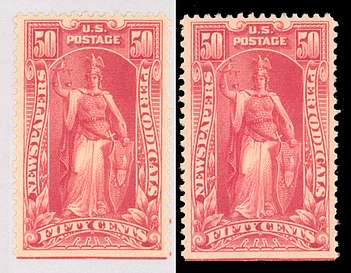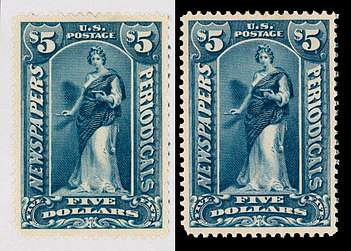| Newspaper And Periodicals Stamps |
| Item # |
|
Mint Hinged US$ |
||
| 249596 |
Scott #PR119 ROSE CARMINE [1895 Designs: 50c "Justice", Watermarked] Mint, hinge remnants, with VF centering, but a tiny thin spot. This is the Rose Carmine color, one of three colors listed by Scott. Despite the hinge remnant and tiny thin spot, this is a beautiful, fresh-looking example with wonderful color and overall appearance. While this is not a "scarce" stamp, examples this nice looking are hard to find. Natural Straight Edge and Guideline at bottom; and tiny part of guideline on the right side perforation tips. This example is from the bottom row of a top pane, from column 5 of the pane (as shown by the guideline at right). My information on the plate layout of the 1895 stamps includes an assumption regarding the size and layout of the printer sheet and the panes into which they were cut. I have not been able to find images of any complete sheets or information for the 1895 printer sheet size or pane size. Per Scott, the pre-1895 designs were printed in sheets of 100 and thus it is likely that the 1895 issue was as well. Based on that... Printed in printer sheets of 100 (?), 10 columns (?) and 10 rows (?). The sheets were divided horizontally (into top and bottom halves) by cutting between sheet rows 5 and 6 (documented by images). The unwatermarked stamps were issued February 1, 1895. The watermarked version started to appear in Fall 1895 and continued with new watermarked denominations into 1897 as the need arose. The plates originally only had arrows in the four margins to indicate where to divide into panes, but the purpose of the arrows in the top margin is unclear to me unless it was intended that the 50-panes be further divided into 25-panes. In November 1895, after production of unwatermarked stamps had been discontinued, actual guidelines were added to the plates, at the arrow locations, both vertically and horizontally (documented by images). A significant-enough quantity of multiples exist spanning the vertical guidelines that there obviously there was not a division into 25-panes early in the processing. Thus... a) Guidelines can only exist on the watermarked stamps. b) The straight-edges apparently only exist horizontally, at the top or bottom of stamps (depending upon the cutting, the guideline -- only present on printings starting in November 1895 -- may have been cut off one stamp and only be on the stamp above or below). c) Vertical guidelines are apparently always perforated. d) Horizontal guidelines are always with a straight-edge (but not the other way around). e) There are apparently no corner straight-edges. f) Corner guidelines can exist. g) Horizontal pairs and larger multiples exist spanning a vertical guideline. Examples with guidelines and/or straight-edges are now quite hard to find due to reperforating, etc. I think that collecting the straight-edge and guideline positions is quite challenging and rewarding. [For this issue, if anybody can clarify, with pointers to references, the plate layout and the reason for the vertical guideline, I would very much like to learn more about this issue.] ACTUAL item. |
13.00 |
||
| 249598 |
Scott #PR121 [1895 Designs: $5 dark blue "Clio", Watermarked] Mint, hinge remnant, with XF centering. Watermark clearly visible without fluid. Very fresh and bright appearance with great color. Guideline on the right side perforation tips. This example is from column 5 of the pane (as shown by the guideline at right) and other than from rows 5 or 6 (as shown by the lack of a straight edge). My information on the plate layout of the 1895 stamps includes an assumption regarding the size and layout of the printer sheet and the panes into which they were cut. I have not been able to find images of any complete sheets or information for the 1895 printer sheet size or pane size. Per Scott, the pre-1895 designs were printed in sheets of 100 and thus it is likely that the 1895 issue was as well. Based on that... Printed in printer sheets of 100 (?), 10 columns (?) and 10 rows (?). The sheets were divided horizontally (into top and bottom halves) by cutting between sheet rows 5 and 6 (documented by images). The unwatermarked stamps were issued February 1, 1895. The watermarked version started to appear in Fall 1895 and continued with new watermarked denominations into 1897 as the need arose. The plates originally only had arrows in the four margins to indicate where to divide into panes, but the purpose of the arrows in the top margin is unclear to me unless it was intended that the 50-panes be further divided into 25-panes. In November 1895, after production of unwatermarked stamps had been discontinued, actual guidelines were added to the plates, at the arrow locations, both vertically and horizontally (documented by images). A significant-enough quantity of multiples exist spanning the vertical guidelines that there obviously there was not a division into 25-panes early in the processing. Thus... a) Guidelines can only exist on the watermarked stamps. b) The straight-edges apparently only exist horizontally, at the top or bottom of stamps (depending upon the cutting, the guideline -- only present on printings starting in November 1895 -- may have been cut off one stamp and only be on the stamp above or below). c) Vertical guidelines are apparently always perforated. d) Horizontal guidelines are always with a straight-edge (but not the other way around). e) There are apparently no corner straight-edges. f) Corner guidelines can exist. g) Horizontal pairs and larger multiples exist spanning a vertical guideline. Examples with guidelines and/or straight-edges are now quite hard to find due to reperforating, etc. I think that collecting the straight-edge and guideline positions is quite challenging and rewarding. [For this issue, if anybody can clarify, with pointers to references, the plate layout and the reason for the vertical guideline, I would very much like to learn more about this issue.] ACTUAL item. |
40.00 |